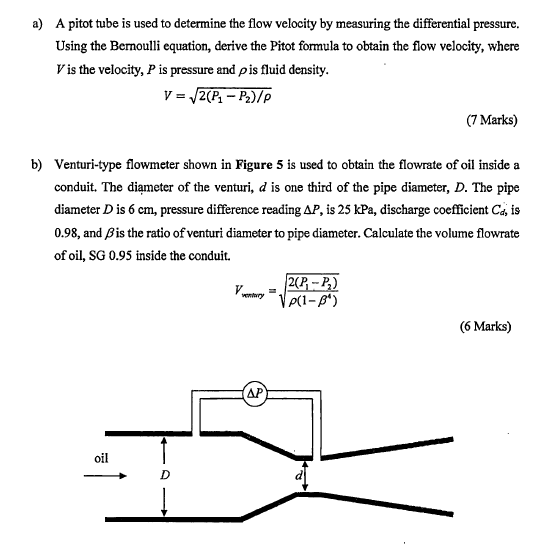

Where is the static pressure of fluid in the pipe, and are the densities of the fluid in the pipe and manometer fluid, is specific gravity of fluid in the pipe, is the gravitational constant, and is the difference in height of the manometer fluid. The following techniques can be used to measure air flow inside ducts, using a velocity probe or pitot-static tube. This equation can be rearranged and used to solve for fluid velocity or difference in height of the fluids in the manometer: Determine the resolution of a manometer required to measure the velocity of air at 50 m/s using a pitot-static tube and a manometer fluid of mercury (S-13.57) to achieve uncertainty of 5 and 1. The equation for the difference in pressure in a manometer is substituted into the simplified Bernoulli equation: Mechanical Engineering questions and answers. Thus we obtain the simplified form of Bernoulli's equation: Velocity Measurement using Pitot Tube Pitot Tube at 54 mm Pitot Tube at 294 mm Static Pressure Reading 56(mm) Static Pressure Reading 58(mm) Traverse. The two points that are being evaluated are at the same height, so and drop out. All terms on the right side refer to point 2, a point upstream from the pitot tube. Fluids of laminar nature cannot be measured with pitot tubes.

3.1) meaning: the flow has to be sufficiently turbulent. Bernoulli's equation is used to calculate the velocity of the bulk fluid in the pipe by using this pressure difference in the pitot tube:Īll terms on the left side represent the stagnation point (entrance of the pitot tube) here is the stagnation pressure and is the velocity of fluid in the pipe at point 1. The average flow velocity v m and the kinematic viscosity of the fluid to be measured in a given pipe size with an inside diameter d must reach a Reynold’s number value Re > 3150 according to the formula Revmdi (Gl. Some kinetic energy density of the fluid flowing through the pipe is converted into pressure, resulting in a change in manometer height. Pitot tubes are used to measure the velocity of a fluid moving through a pipe by taking advantage of the fact that the velocity at the height of the bend in the tube (stagnation point) is zero.


 0 kommentar(er)
0 kommentar(er)
